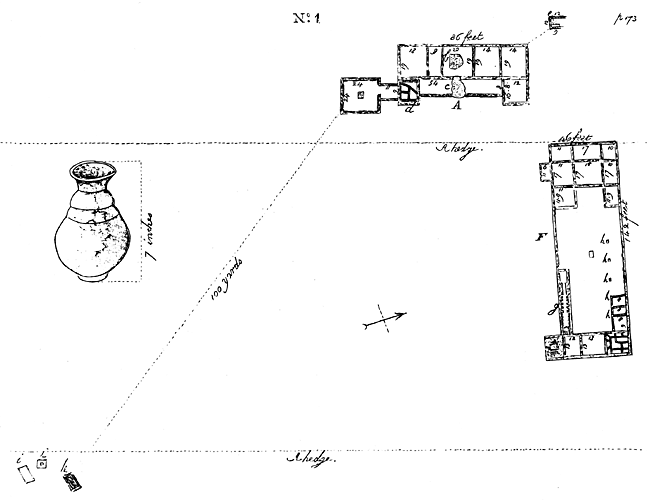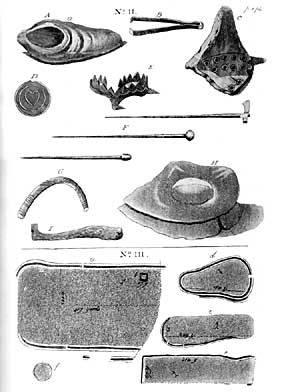Antiquities upon Shirewood Forest, and in the Neighbourhood of Mansfield Woodhouse

Fig. 1.
In the year 1786, Hayman Rooke, Esq. of Mansfield Woodhouse, discovered, within a mile and half of that Village, two Roman Villae. What led to this discovery was his having seen several small Tesserae, which the Romans used in their pavements, said to have been found in the north fields, where, in digging about a foot below the surface, the labourersa came to a wall, which, by following, Mr. Rooke traced out a complete Villa Urbana; (a) consisting of nine rooms and a hypocaust. See the plan, (A) in No. 1. In clearing out the earth, which was a foot deep to the floors, the walls of most of the rooms appeared to have been stuccoed and painted in the stripes of purple, red, yellow, and green. In the centre room, marked (b) in the plan, is part of a very elegant Mosaic Pavement; this room was probably the triclinium, or dining-room.
The entrance of this Villa seems to have been on the east front, into a narrow cryptoporticus, marked (c) with painted walls and a tesselated pavement; the cubes near an inch square of a light stone colour; at one end of the cryptoporticus is the hypocaust (d) to which the heat was conveyed through an arch under the wall from the other side, where the fire was made, and a quantity of ashes found.
At about fourteen feet from the north-west end of this Villa, was a building, marked (e) which he imagines was a necessary convenience. The Villa Rustica, marked (F) in the plan, certainly belonged to the Villa Urbana, the distance being only ten yards from the north-east end. This Villa consists of thirteen small rooms, two hypocausts, a cold bath, and what Mr. Rooke then thought, a court in the centre, but as he has since discovered a fire-place in the middle, he thinks it must hav ebeen covered in; three of these rooms had painted walls, in that on the east end, near the hypocaust and cold bath, which he supposes to have been the apodyterium, or stripping room, the colours were remarkedly bright. In clearing out the large hypocaust (g) several pieces of a smooth stucco floor were found, which Mr Rooke supposes to have been the floor of the Sudatorium and calida lavatio over the hypocaust. In the inside wall of the little room were fixed two oblong bases of pillars, marked (h) in line wqith the other two, these being marked (h) in the plan; on the tops of these stones bases are grooves, but as they are not all of the same dimensions, Mr. R. does not imagine they were intended for pillars, but rather supposes, they were bases of altars, dedicated to local deities.
At about one hundred yards south-east of the Villa Urbana, Mr. Rooke discovered two Roman sepulchres — see (i) and (k) nothing remains of (i) but the foundation; the other was more perfect. The remains of the side walls were about one foot under ground, in clearing two feet of earth, he came to a stucco floor, which covered one large flat stone and two or three small ones. These were laid over a cist or little vault, seven feet long, two wide, and one foot six inches deep : This was full of a very light kind of earth; in the bottom stood an Urn, containing ashes, which had been cracked by the weight of the earth, and fell to pieces on beig removed. Two small bones of the arm, two rib bones, and four or five joints of the back bone, lay scattered in the bottom; these were what probably had escaped the fire and were afterwards deposited with the urn. Between the two sepulchres is a pavement seven feet square, marked, (l) in the centre was a kind of pedestal, part of it broken; on this probably was placed a stone with a sepulchral inscription, fragments of which were found in clearing away the earth from the pavement, but not being able to recover them all, Mr. R. could not make out the inscription.
Many fragments of paterae and pots of different kind of Roman ware, were picked up in clearing out the rooms, some of a dark colour, thin, hard, and elegantly ornamented with indented work; a small patera of the best kind of red ware had ALBVS, the maker's name, in Roman capitals, at the bottom. Several pieces of a large stage's horns were found, some had been sawed off, one piece, in particular, had been sawed and smoothed on each side, and stamped with a circular mark. Many bones of animals, boar's tusks, and some remarkable large teeth, supposed to have been horses, were found in both Villae.

Fig. 2.
Antiquities found in the Villa, see No. 2.
A. The top of a Lamp of yellow pottery.
B. A Brass Nipper which still retains its elasticity.
C. A piece of a Cullender.
D. Part of a circular Ornament with narrow borders of a yellow
metal, within these it has the appearnace of green enamel, but now much
defaced.
E. Seems to have been part of a brass fibula, it was found sticking
to the coulter of a plough, in a field near the villa.
F. Three Ivory Pins.
G. Part of a Brass Ornament, which has now a fine green polish.
H. Seems to have been a kinf of Strigil or Rubber, which the
Romans used to rub their skins with. It is of a pale grey colour, the
bottom smooth; the indented rim was probably intended for fixing a cloth
round it, when a more gentle friction was required.
I. An Iron Key much corroded by rust.
Several Roman Coins were found, some very small, three of Constantine
very perfect, the heads of the others hardly perceptible except one of
Claudius Gothicus, and one of Salonina.
Source
- Thoroton's History of Nottinghamshire: republished with large additions by John Throsby, vol II, p173-176, 1790.
